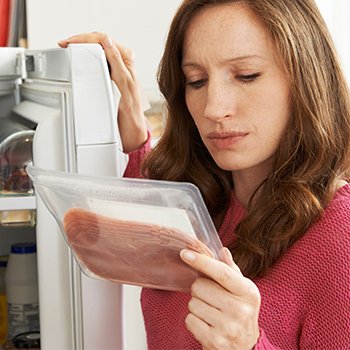บรรจุภัณฑ์อัจฉริยะ เพื่อการตรวจติดตามและวินิจฉัยคุณภาพของเนื้อสัตว์และสัตว์ปีก Intelligent Packaging for Monitoring and Analysis of Meat and Poultry Quality
1051 Views |

By: ดร. อินทัช หงส์รัตนวิจิตร
Intatch Hongrattanavichit, Ph.D.
Department of Imaging and Printing Technology
Faculty of Science
Chulalongkorn University
intatch.h@chula.ac.th
ในปัจจุบันปริมาณขยะที่เกิดจากการเน่าเสียของอาหารเพิ่มขึ้นอย่างต่อเนื่อง จากข้อมูลของสถาบันบัณฑิตพัฒนบริหารศาสตร์ หรือนิด้า (National Institute of Development Administration; NIDA) พบว่า การเพิ่มขึ้นของขยะอาหารเป็นปัญหาหลักในภาคเศรษฐกิจ เช่น การสูญเสียทรัพยากรอาหารของชาติ อีกทั้งยังเป็นปัญหาด้านสังคมและสุขภาพที่เกี่ยวข้องกับความกินดีอยู่ดีและสุขภาพของประชาคมโลก นอกจากนี้ ข้อมูลขององค์กรอาหารและเกษตรแห่งสหประชาชาติ (Food and Agriculture Organization of the United Nations; FAO) ระบุว่าการเสื่อมสภาพของวัตถุดิบเนื้อสัตว์ได้สร้างขยะอาหารมากถึง 1.6 พันล้านตันต่อปี เนื่องจากวัตถุดิบเนื้อสัตว์เป็นอาหารที่เน่าเสียได้ง่าย (Perishable foods) หากมีการถนอมหรือเก็บรักษาที่ไม่เหมาะสม จะไม่สามารถนำเนื้อสัตว์ไปประกอบอาหารได้ทันในช่วงเวลาที่วัตถุดิบมีคุณภาพดีที่สุด ดังนั้น บรรจุภัณฑ์ที่ป้องกันสภาพแวดล้อมจากภายนอก (Passive packaging) ที่มีการใช้มากที่สุดในปัจจุบันนั้น อาจจะยังไม่เพียงพอต่อการแก้ไขปัญหาขยะอาหารที่เพิ่มขึ้นอย่างต่อเนื่องได้
แนวทางการแก้ไขปัญหาด้วยบรรจุภัณฑ์อัจฉริยะ (Intelligent packaging)
การแก้ไขปัญหาที่เกิดขึ้นกับผลิตภัณฑ์เนื้อสัตว์นั้นสามารถทำได้ด้วยการพัฒนาบรรจุภัณฑ์อัจฉริยะซึ่งเป็นหนึ่งในวิธีที่สามารถลดปริมาณขยะอาหารและปัญหาที่เกิดขึ้นได้ เนื่องจากบรรจุภัณฑ์ชนิดนี้จะมีองค์ประกอบของตัวชี้วัด (Indicator) ที่สามารถเกิดอันตรกิริยา (Interaction) กับผลิตภัณฑ์ หรือสิ่งแวดล้อมภายในบรรจุภัณฑ์ที่มีการเปลี่ยนแปลงไปตามช่วงเวลาและสภาวะการเก็บรักษา โดยตัวชี้วัดจะทำหน้าที่ในการตรวจสอบ บันทึก สื่อสาร และเพิ่มการรับรู้ในรูปแบบของสัญญาณ เพื่อให้ผู้บริโภคสามารถตัดสินใจเกี่ยวกับคุณภาพของผลิตภัณฑ์ ความปลอดภัย และผลกระทบที่อาจเกิดขึ้น นอกจากนี้ บรรจุภัณฑ์อัจฉริยะยังสร้างการรับรู้ให้กับผู้บริโภคได้ทุกเพศและทุกวัย ทั้งเด็ก ผู้สูงอายุ บุคคลที่ไม่รู้หนังสือ และผู้ที่มีปัญหาสายตา เนื่องจากบรรจุภัณฑ์อัจฉริยะนี้สามารถส่งสัญญาณในรูปแบบของการเปลี่ยนแปลงสีที่เข้าใจได้ง่ายและสอดคล้องกับคุณภาพของผลิตภัณฑ์ภายในบรรจุภัณฑ์ ทำให้ผู้บริโภคสามารถตัดสินใจและนำวัตถุดิบเนื้อสัตว์มาประกอบอาหารได้ทันเวลาก่อนที่วัตถุดิบจะเน่าเสียและกลายเป็นขยะอาหาร อีกทั้งอาหารยังมีคุณภาพเหมาะสมต่อการนำไปรับประทานโดยไม่ก่อให้เกิดปัญหาด้านสุขภาพต่อผู้บริโภค
In the present day, the amount of food spoilage waste is continuously increasing. According to the data from the National Institute of Development Administration (NIDA), the increase in food waste is one of the significant problems in the business sector. For instance, the loss of food resources on the national scale has become social and health problems that consequently affect the global community and its living standards. In addition, the data from the Food and Agriculture Organization of the United Nations (FAO) revealed that the spoilage of raw meat is responsible for 1.6 billion tons of annual food waste because meat is a perishable food whose optimum quality can be compromised if it is not correctly preserved, stored, or used for cooking within its best-before period. Hence, relying solely on passive packaging, the type most commonly used for meat products nowadays, may not be enough to curb the continuous surge of food waste.
Guideline for Solving the Problem via Intelligent Packaging
Meat spoilage issues can be tackled by developing and applying intelligent packaging, an alternative solution that can reduce food waste. The intelligent packaging features indicators that interact with food products or the internal environment inside the packaging that might be changed in response to time and storage conditions. They can monitor, register, and provide information signal about the product’s current state so that consumers can make an informed decision based on the product’s quality, safety, and potential consequences. Moreover, intelligent packaging can also build awareness for consumers of all genders and ages, including older people, children, illegible people, or those with visual impairment, since the product’s conditions and quality can effectively be determined through color change, which can be easily understood by consumers, related to the contained food. As a result, consumers can decide when to use the meat product for cooking before it deteriorates and becomes food waste. It also ensures that the meat product retains the ideal quality for consumption without any health risks.






